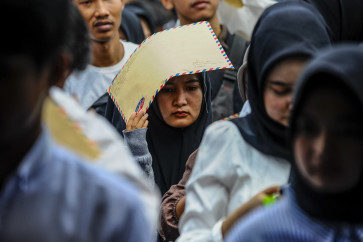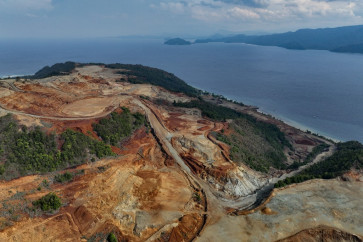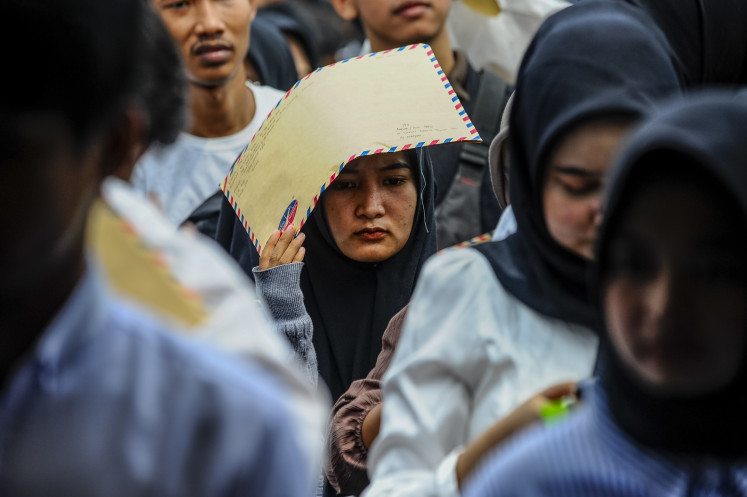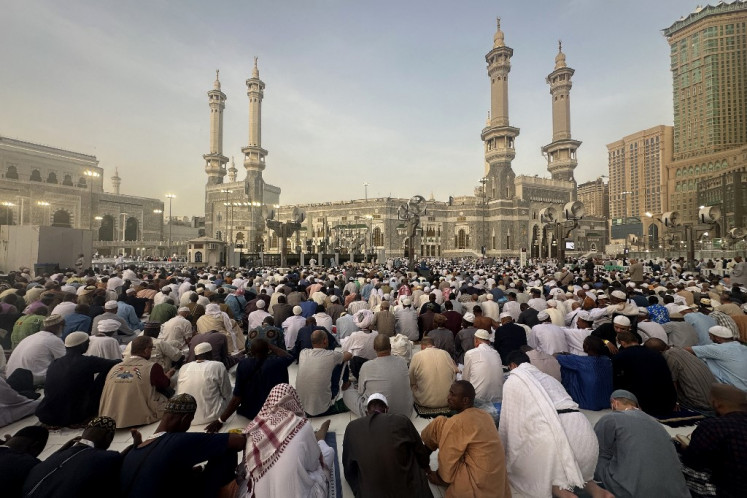Art Exhibition: ‘Lanskap Tubuh’ a deconstruction on canvas
Inside me: A visitor observes at Chandra Johan’s painting titled Aku #1 (2010)
Change text size
Gift Premium Articles
to Anyone

Inside me: A visitor observes at Chandra Johan’s painting titled Aku #1 (2010).
Chandra Johan completed his journey as a painter at his solo exhibition a year after his passing, a summary of three-decades of his extraordinary works.
The saying that a picture is worth a thousand words might be a cliché, but Chandra’s paintings are more literary works than mere acrylic brushstrokes on canvas.
Through his works, the painter guides us to look through an object the way it should be seen — in a deconstructive manner by peeling it off layer by layer until it reaches the core and leaves it bare for free interpretation.
“Chandra Johan is indeed the legitimate son of post-modernism,” said poet, art and design curator Eddy Soetriyono, the curator of the ongoing exhibition at Cemara 6 Gallery, Central Jakarta.
Titled “Lanskap Tubuh” (Body Landscape) after Chandra’s work of a deformed headless body in 2010, the exhibition showcased his continuously evolving artistic vision and his personal explorations as an artist from 1997 to 2015.
Born in Langkat on Aug. 21, 1957, Chandra took formal education at the Bandung Institute of Technology majoring in arts and design.
Although he had started painting while at university, he took a formal job as an art director of a design firm upon his graduation in 1987. After a year, he moved to a national magazine as the artistic editor.
But working behind the desk failed to keep him away from his calling and he started to work with the easel professionally in 1991.
Eddy said Chandra’s style in his early years was super-realist and laden with social critique but evolved into something more eclectic and pastiche in 1996, when he began to adopt various styles in his works.

Dua stupa (2001)
“From 2000 his paintings were more of a mixture of realist and abstract styles, but 2003 served as a turning point as he come up with his own style by freeing himself from any expression known to modern art,” said Eddy.
However, he said, the artist had been consistent in his search to define the “abstract” form of realism that reflected his rebellion against the school of thought of his lecturers at that time, which set aside abstract as a correct form of artistic expression.
“Many of his works are already in the hands of collectors. The exhibits are the available ones, but enough to represent the journey.”
The curator mainly picked works that expressed the big three themes of his last period; namely figurative, stupa and cityscapes — with a small number of his works from the earlier period of the same theme.
The larger-than-life self-portrait Aku #1 (2010) welcomes gallery visitors, depicting the painter with a painful expression trying to strangle himself with string.
Colored in a green hue, the painting reflects the reality that there is always an abstract form inside a man that could be anger, a sense of humor or insanity.
Chandra, who also loved literature, made his own interpretation of the main character in a Budi Darma novel with Homo Rafilus the Face series in 2015, a pink painting of a man with a deformed face.
Two of the three-panel paintings titled Dance in predominantly red hues depict a man object dancing with a lot of things going on inside his body.
“There is a landscape of something inside the object that Chandra zoomed into in the third frame,” said Eddy.

Dance (2008)
The deconstructive style of German painter Gerhard Richter was also an influence in Chandra’s works as seen in his Borobudur or Stupa series in which he took out one element of the whole and as if working on multiple windows of a computer, Chandra moves out each layer to a different panel.
“The Stupa is historically the symbol of the tree under which Buddha became enlightened. In itself, Stupa is an abstract form,” explained Eddy.
The painter’s design background was also at play in the rectangular, geometrical division of panels in a frame as well as the merging of letter and number type fonts in the paintings, which can clearly be seen in his cityscape portraits.
Abandon (2014) embodies the story of a city with vacant tall buildings standing alone atop of wide black swathes against a sparse horizon.
In memoriam Chandra Johan (1957-2015)
Painting exhibition “Lanskap Tubuh”
June 2 to 21, 2016, from 10 a.m. to 8 p.m.
At Cemara 6 Gallery
Jl. HOS Cokroaminoto No. 9-11, Jakarta Pusat
Despite the gloomy nature of City of Grey , the series conveys an overall sense of exuberance, the depiction of the spiritual void of urban life clearly captured in the paintings.
In all of his works, Chandra exposed the juxtapositions of different elements: gloom in pastel colors; realism and abstraction; creation and neglect as well as mortality and infinity.
“The landscape of his mind, in which he no longer sees an object as a mere object, has become his signature that connects all of his works,” said Eddy.









